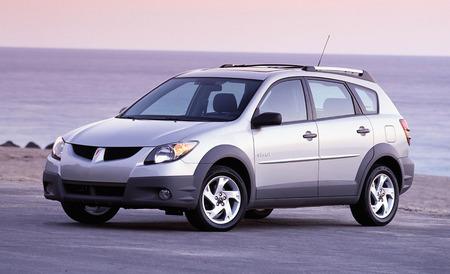The Pontiac Vibe steers GM into a new territory of small sport wagons, an area it has largely and perhaps understandably ignored since the Chevy Vega.
Actually, the term wagon is so taboo around GM these days that the company beseeched us mightily not to use it in this preview story.
“It’s not really a full station wagon,” hastens Vibe brand manager Craig Bierley. “Wagons are much lower and longer, with more space behind the rear seats. Saying it’s a wagon is probably reaching. This is a high-function five-door.”
Well, the car — is car okay? — has been developed by Toyota with some inspiration from and participation by GM engineers and Pontiac brand managers. The result is a clever morphing of the handling traits of a light car, the elevated seating position of a truck, and the utility of a certain body configuration whose name begins with a “w.”
Both the Vibe and its sister car, the Toyota Matrix, will offer the same two engines and three driveline choices. The base 1.8-liter DOHC in-line four offers 130 horsepower and 125 pound-feet of torque. It will turn the front wheels through a five-speed manual or four-speed automatic. A hands-free four-wheel-drive system using a viscous wet-clutch center coupling will be available only with the base engine (in 120-hp trim) and either manual or automatic transaxles. The GT will have the same 1.8-liter block fastened to a Yamaha-developed cylinder head offering 11.5:1 compression and featuring Toyota’s variable valve timing and lift system (VVTL-i). That hot 180-hp motor is from the Celica GT-S, and this model will come with front-drive only, bolted to a six-speed manual gearbox, and include firmer springs and shocks, stiffer control-arm bushings, thicker anti-roll bars, and standard ABS on four disc brakes bearing Akebono calipers.
Except for the outside mirrors and roof panel, which are shared, the Vibe and Matrix wear different skins. GM designers tried to give the Vibe a characteristic Pontiac look without the characteristic yards of plastic tack-on.
“We wanted to keep a clean look,” says assistant brand manager James Hunter, so body side ribs were limited to subtle spears on the front and rear bumpers, small blisters in the taillights, and tiny riblets in the headlight clusters. Does this mean future Pontiacs will get by with less plastic? “It’s a safe bet,” says Hunter.
GM spent money to liven up the dashboard with red backlit gauges ringed by elegant chrome bezels. Chrome and brush-finished electroplated plastic will add even more burnish, while GTs will get a leather-wrapped steering wheel and shift knob.
The rear-seat bottoms move forward and the seatbacks fold flat in one smooth, articulated motion that creates 57 cubic feet of flat-floored cargo space, not much less than in the Saturn VUE. Tracks set in the plastic rear floor will accommodate a forthcoming range of dealer-sold accessories, including picnic tables and pet screens. The glass in the two-piece tailgate is hinged to open separately from the door.
A 200-watt single-CD player, a roof rack, and a 110-volt two-prong dashboard outlet will be standard. Otherwise, Pontiac plans to keep the Vibe’s order sheet simple when it hits dealerships in February. Buyers can choose their powertrain, 17-inch wheels with unidirectional tires, an upgraded stereo with an in-dash six-CD stack or navigation system, a sunroof, and a Power package that includes keyless entry. Eight colors will be offered, including lime green, and buyers can pay extra if they desire body-colored lower cladding. GM says to expect “popularly equipped” two-wheel-drive versions to be about $18,500.
GM is using the Vibe as a spearhead into the small-car aftermarket. Within 12 months it expects to have a full catalog of accessories that includes a dealer-installed supercharger kit. The blower is expected to raise the power of the base engine to the GT’s 180 horsepower and top it off with a more substantial increase in torque.
Whatever Pontiac chooses to call it, the well-equipped Vibe looks to us as if it will be a definite “w” for “winner.”


Leave a Reply